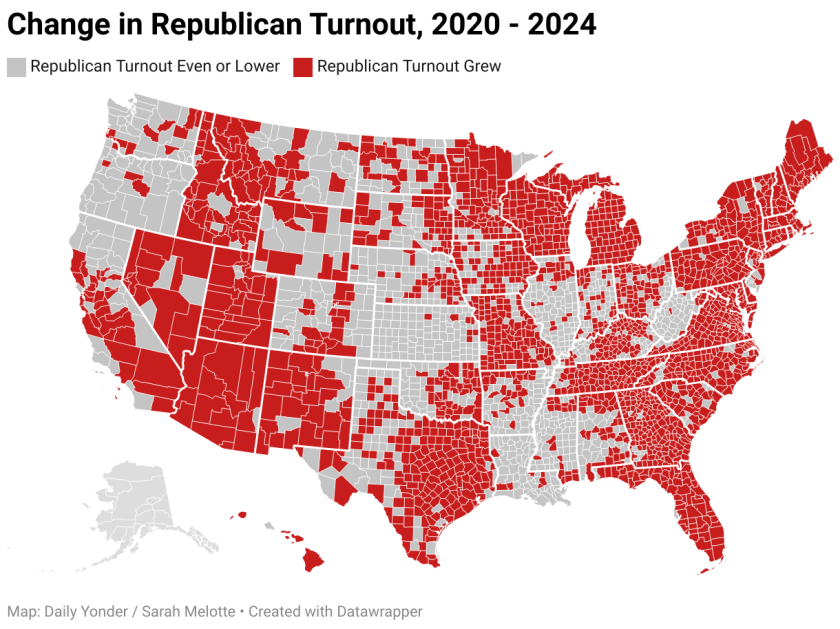But it’s impossible to have a discussion about these issues without a deluge of comments that rural voters “brought it on themselves” by supporting Donald Trump. (One example: the comments belowthis MSNBC interview with former Montana Senator Jon Tester and Mitch Landrieu.)
We know: Never read the comments. But in this case, these sorts of discussions reveal a generally accepted wisdom that rural America is solely responsible for Trump’s election.
Those arguments are wrong. We’ve already reported on the collapse of urban support for the Democratic presidential candidate in 2024. Our new analysis shows that this collapse was centered in urban areas that are gaining population.
Yes, Trump’s supermajority among rural voters nationally was part of his formula for victory. But our analysis shows that Democrats’ more important failure was a sharp drop in support in growing cities.
In these population growth centers, Democrats simply didn’t show up, and the result was a Republican victory.
Two Key Findings
Let’s look at a couple key facts from 2024:
First, the number of Democratic votes dropped dramatically from 2020 to 2024. There 6.2 million fewer Democratic votes in 2024 than in 2020.
And, no, that is not because those voters shifted to support the Republican candidate. The number of Republican voters increased by only 2.7 million between 2020 and 2024. So about 3.5 million voters who sided with Democrats in 2024 simply didn’t show up in November.
Why? Were they protesting, busy or simply pouting? We don’t know.
Second, the decline in the number of Democratic voters was almost entirely a phenomenon found in the parts of the United States that have been gaining population. The Democratic pout was confined to larger counties that have been attracting new residents. Those cities are where Republicans won the 2024 election, not in rural America alone.
What do the numbers tell us? Below is the change in total votes between 2020 and 2024 by party. Yes, Republicans gained votes. But, again, that increase alone doesn’t explain the difference in Trump’s performance compared to 2020. While the GOP gained voters, nearly twice that many voters disappeared from Democratic totals. Democrats simply didn’t show up. Thus, the Great Pout.
Counties That Gained and Lost Voting-Age Population
A little over 40 percent of the country’s 3,144 counties lost voting age population (older than 18) between 2020 and 2024. The other 60 percent of counties gained voting age population. In the growing counties, the voting age population increased by about 2.4%, or 3.9 million people.
Counties that lost voting age population between 2020 and 2024 had smaller populations, on average, than counties that gained population. In 2024, the average size of shrinking counties was 77,000 residents, compared to an average of 88,000 in counties that gained population.
Republicans increased their turnout in both types of counties – ones that added population and ones that lost population. And, conversely, Democrats lost total turnout in both types of counties. But the Democratic losses were not evenly distributed between growing and shrinking counties.
About one third of Republican raw vote gains came in counties that were growing in population. Meanwhile, more than half (3.2 million votes) of the Democratic decline in turnout occurred in counties that were adding population. Hence, a disproportionate share of the Democratic decline occurred in these growing urban areas.
The following maps show where each party gained raw votes. You’ll notice that counties where Republicans gained votes cover a lot more territory than the Democratic turnout map. (The two maps aren’t mutually exclusive. Both Democratic and Republican turnout increased in nearly 600 counties.)


West Coast Saw Biggest Drop in Democratic Turnout
The Big Pout had the greatest numerical impact in counties of the Coastal West, which includes California, Oregon, and Washington. In those states, Democrat Kamala Harris had about 2 million fewer votes in 2024 than Joe Biden did in 2020.
In the Coastal West, about 60 percent of this drop in Democratic turnout happened in counties that gained voting age population between 2020 and 2024. The Coastal West gained over 117,000 people of voting age during this time period.
Support for Trump also declined between 2020 and 2024 in the Coastal West, losing about 17,500 Republican votes in the last election cycle.
Counties in the South had the second largest drop in Democratic turnout. Here, Harris had 1.4 million fewer votes than Biden did in 2020. Over 90 percent of the drop in Democratic turnout in the South happened in counties that gained voting age population between 2020 and 2024.
Unlike the Coastal West, however, support for Trump in the South increased. In 2024, Trump saw an increase of about 1.4 million compared to his 2020 turnout.
The final map shows the net change in the two-party vote from 2020 to 2024. Republican gains are shown in red, Democratic gains in blue.
It wasn’t in the “left behind” counties that Democrats faltered, in other words, but in the counties that have been attracting new residents.
Some Democrats like to say the party appeals to people who see innovation and opportunity on the horizon. For example, Hillary Clinton boastedthat in her 2016 loss to Trump she got more votes in counties that were a bigger share of the nation’s gross domestic product. The inference is that Democrats are the future and economic progress.
Our analysis shows a much more complicated picture. Democrats seemed most disaffected in areas where voter rolls ought to be growing. And whatever that means, it’s nothing to boast about.
This story was first published in the Daily Yonder. Read the original here.








